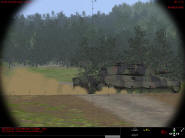Steel Beasts Pro
Personal Edition
March 12, 2006
Page 1: Introduction Page 2: Opening Shots Page 3: Graphics Page 4: Sound Page 5: Mission Edit Page 6: Vehicle Park Page 7: Game Logic Page 8: Gameplay Page 9: Stability Page 10: Summary
Page 5b: Editing and mission designing
Editing and mission designing
On the editor: you get a mission editor, as said above, and a map editor that allows you to define type of terrain, object placing, vegetation, and how fast various kinds of vehicles can move in a given terrain. To be more precise, the map editor as the primary design-tool also includes the so-called terrain theme editor in form of a program that opens from within the map editor in a separate window, the latter allowing to change movement parameters for different mobility properties, and to change the visual appearance of the ground textures. You can essentially determine not only what kind of terrain should appear at a location (and what vegetation, objects, buildings), you can also determine what effects the selected terrain type should inflict on unit movement in the designed scenario. These changes are not global but are saved as integral part of the scenario file. However, there is no height map editor (only the military is getting that, not the PE version), so you cannot change the 3D-modelling of the earth’s surface, its valleys and hills. But the simulation comes with 60 huge height maps, which can be multiple times a big as the actual mission maps, so only a fragment of a single height map is used at a time to form up the approximately 13x13 km battleground for the actual mission (there are height maps included of up to 60x50 km).
And you can nevertheless turn the same area on the same height map into a very different terrain by using the map editor to go over it, turning desert into woodland with rivers and forest, for example. Additionally, a member of the beta-testers who are in contact with the developer told me this: "In the map editor, you can modify terrain up to 80x80km˛ in size. In the mission editor, you can pick maps of up to 20x20km˛, of which the recommended battle space usually is 12x12km˛. At the edges of the mapped area, Steel Beasts performs a wrapping of the terrain. This requires a transition zone where height differences are leveled out. This transition zone should be at the very edge of the player's visibility limit to avoid an immersion-breaking "discovery of the ugly truth". Many of the included height maps, according to their titles, seem to mimic realistic terrain from around the globe, from the Gulf over Asia to Germany, from the Balkans to the Arabian deserts, from Korea to US terrain (Fort Hood or the complete NTC, for example). If you are a mission designer and think the lacking ability to manipulate the height maps is a showstopper for mission designer, then you should build your own experience on it by trying it – the disadvantage is much smaller than one may conclude from my words. In their forum it was also said by some guys some time ago, that maybe there are ways to bypass the missing height map editor, and that it is possible to manipulate terrain height, nevertheless. But take this with caution - it was also said that this is an extremely complicated and difficult process that is not recommended to be tried by the faint of heart. The option to manipulate height maps was intentionally left out, so that the military still will buy the more expensive version that allows doing that, by importing DTED and ESRI formatted data.
Importing the missions from SB1/Gold can be very easy for not too complex terrain, just drop the missions into the according SBP-folder, and the sim will recognize them. Other missions eventually will need to add some substantial manual corrections. But it is possible to increase the number of SP mission from the default 26 to over 140 missions, in a very short time. If it is recommended to do so with every old mission is something different. Sometimes it may be easier to design a mission from scratch.
Next: Page 6: Vehicle Park
Page 1: Introduction Page 2: Opening Shots Page 3: Graphics Page 4: Sound Page 5: Mission Edit Page 6: Vehicle Park Page 7: Game Logic Page 8: Gameplay Page 9: Stability Page 10: Summary
System Requirements (Recommended specs are in parentheses.): 1.5 (2.5) GHz CPU; 256 (512) MB RAM; 64 (128) MB, DirectX9-Capable Graphics Accelerator (GeForce 3 class or better); 1.6 GB available hard disk space; Free USB port; Mouse; CD-ROM; Microsoft Windows 2000 / XP with Service Pack 2 installed. (Steel Beasts will NOT run on Windows NT.); Microsoft DirectX version 9.0 (or better) installed; For better playing experience, a sound card and joystick are recommended.
****** Updated regularly ******
Want to know when patches are available?
Want to be informed of the latest breaking Steel Beasts news?
Sign up for the Tanksim Newsletter!Copyright © 2006 Tanksim.com

